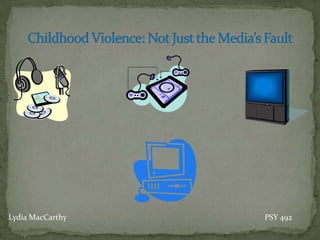
Childhood Violence
- 1. Childhood Violence: Not Just the Media’s Fault Lydia MacCarthy PSY 492
- 3. In a study done by the American Psychological Association, it was estimated that a child has watched 100,000 acts of violence and 8,000 acts of murder by the time he or she leaves elementary school (Danielewicz, 2005). Not to mention that the average American child will spend 6 hours and 42 minutes a day viewing various types of media, and 81% of those children aged 2-7 are using these types of media unsupervised (Danielewicz, 2005). Researchers have also indicated that 3-10% of the population is pre-disposed to act violently when frustrated (Coyne, 2007). STATISTICS:
- 4. Results from a survey that was distributed to parents/guardians in three different urban locations included questions related to television viewing/monitoring, showed a variety in practices and attitudes toward television violence viewing and monitoring among the parents (Brenner, 2004). These attitudes and practices varied depending on the child’s age and the gender of the parent (Brenner, 2004). Of the 1004 participants, 922 responded, 830 being parents. SURVEY:
- 5. Other influential factors that need to be taken into consideration when talking about childhood acts of violence are: Physical/emotional abuse by parent(s) or guardian(s) Living in a violent neighborhood or home Poverty Inconsistent discipline (Coyne, 2007) Keep in mind these are not “excuses” these are just possible factors that might contribute to violent behavior. OTHER INFLUENTIAL FACTORS:
- 6. Since a majority of us have viewed violent images, played violent video games, and listened to abrasive lyrics throughout our lives why is it that we aren’t out committing violent acts? Researchers have hypothesized that some people are more prone to the effects of viewing violent media than others (Coyne, 2007). INFLUENTIAL FACTORS CONT.:
- 7. One of the most influential theoretical perspectives on screen violence is believed to be the social learning theory (Follina, 2006). Bandura did a study looking at the circumstances where children would replicate aggression following observation (Follina, 2006). The study showed that children who were exposed to aggressor gaining rewards without being punished were more prone to replicate these behaviors than those children who were exposed to aggressors being punished (Follina, 2006). This study turned into what we know now as “observational learning”. If we aren’t told otherwise when we’re young, we are more likely to re-enact what we see in T.V., movies, or video games. SOCIAL LEARNING THEORY:
- 8. Why do crime rates seem to rise and fall? Reasons could include: Rise and fall of poverty rates Demographic trends Access to handguns Social structure (Coyne, 2007) If you look at the recession we are in now, it’s easy to see how people who are struggling would resort to measures they normally wouldn’t resort to otherwise. FACTORS IN RISING CRIME RATES:
- 9. When blaming the media for one thing, we can blame the news networks for over exaggerating crime both locally and nationally. Research has shown that “crime saturated” local and national news reports increase viewers perception of both personal and overall risk regardless of actual danger (Olson, 2004). We see this every year around flu season. News reports state that it’s the “worst flu season”…..every year! NEWS REPORTS:
- 10. We’ve had so many technological advances when it comes to media it has become easier than ever for parents to monitor and block shows and websites based on their content or rating. Also, it has become mandatory for all television shows, movies, video/computer games, and music to have a rating system and an explanation of that rating available to the public. As a parent it is important to become familiar with these rating systems, so you know what is and isn’t appropriate for your child. TECHNOLOGICAL ADVANCES:
- 11. Probably the most influential factor in a child’s life are the parents. They not only have the ability to monitor and stop their child from viewing various types of violent media, but they have the power to teach them about the media they are viewing. They not only need to talk to their children about the consequences of violent behavior, but also other potential dangers such as drugs, and STDs, which they will also view in media. It’s always important to start young, you want to tone down the effects of media violence messages so children understand that even though they do this in the movies or in video games, in real life there are consequences for those kinds of actions (Henry Kaiser Foundation, 2000). PARENTAL INVOLVEMENT:
- 12. When it comes to various forms of violent media, it’s not going away any time soon. Hollywood and news ratings are higher when it comes to the “shock and aw” effect on the public. There are so many different types of intervention strategies when it comes to viewing violent media that it’s hard to place all the blame for violent behavior on media itself. Violence, unfortunately, is a part of the world we live in, and has been for centuries. Until that violence goes away completely, there will always be violent images to see. It’s important to remember that people were murdering and hurting each other long before television, movies, and video games were even introduced. CONCLUSION:
- 13. Brenner, R., Cheng, T., Moyer, P., Sachs, H., Wright, J. (2004). Children’s Violent Television Viewing: Are Parent’s Monitoring? Pediatrics, Vol. 114 No. 1. Coyne, S. (2007). Does Media Violence Cause Violent Crime? Danielewicz, J., Jason, L., Mesina, A. (2005). Reducing Media Viewing: Implications for Behaviorists. Follina, F., Steward, J. (2006). Informing Policies in Forensic Settings: A Review of Research Investigating the Effects of Exposure to Media Violence on Challenging /Offending Behavior. The British Journal of Forensic Practice: Criminal Justice Periodicals, pg. 31. Kaiser, Henry J. Foundation (2000). Talk with Your Kids Before Someone Else Does: Talking with Kids about Tough Issues. Olson, C. (2004). Media Violence Research and Youth Violence Data: Why Do They Conflict? REFERENCE: